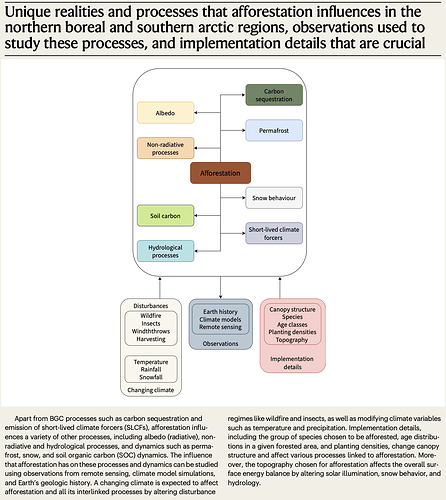This week, we deep dive into a working paper, recently published in Nature Communications. The study was led by Kevin Bradley Dsouza, from the Department of Earth and Environmental Science of the University of Waterloo in Waterloo (Canada).
This paper evaluates the climate impact of afforestation in Canada’s northern boreal and southern arctic regions, showing that focusing solely on carbon sequestration overlooks key biophysical effects like albedo, permafrost dynamics, and short-lived climate forcers. The authors propose a six-part integrated assessment framework to capture these complexities. Their findings challenge simplistic “carbon good, albedo bad” conclusions and emphasize site-specific, long-term analysis, offering guidance for science-informed, climate-smart afforestation policy.
This study explores the interconnections of forest processes, revealing that afforestation is a more complex decision than it may initially appear. The case of Canada’s northern boreal and southern arctic regions is especially interesting as these areas are warming 2–4× faster than the global average and contain vast carbon stocks.
Their findings highlight that forests impact more than carbon—they affect albedo, surface energy balance, hydrology, permafrost, soil carbon, short‑lived climate forcers (SLCFs), and forest structure. Most afforestation studies in high-latitude regions focus narrowly on carbon, overlooking many other key factors, and often neglect variations in forest age, species, seasonality, and landscape features, resulting in oversimplified results. To address this, the authors propose a six-part framework that encompasses the full climate impact of afforestation, encompassing biogeochemical, biophysical, hydrological, and atmospheric aspects. This approach integrates field data, remote sensing, and models, emphasizing time-sensitive and site-specific analysis.
Results indicate that the climate impact of northern afforestation isn’t one-size-fits-all—it depends on a full accounting of effects like albedo, permafrost preservation, and short-lived climate forcers. While past studies often flagged high-latitude forests as warming due to lower albedo, this paper shows that broader impacts can tip the balance toward net climate benefits. The proposed six-part framework offers a practical tool to guide research and policy, ensuring afforestation strategies are both effective and climate-informed, ensuring a detailed mapping, integrated modeling, and context-specific forest design to improve assessments
Here is a list of the main takeaways of this paper:
- Afforestation’s climate impact in high latitudes is complex: it involves more than just carbon uptake, including albedo, permafrost, and atmospheric effects.
- Carbon-only assessments are insufficient — ignoring non-carbon processes can lead to misleading conclusions about climate benefits or harms.
- The authors propose a six-component evaluation framework, capturing biogeochemical, biophysical, hydrological, and atmospheric processes over time.
- Site-specific and long-term analysis is essential: forest effects vary by location, species, climate conditions, and forest age.
- Policy and planning must integrate these complexities to ensure afforestation strategies are truly climate-effective and context-appropriate.
Read the full paper here: Assessing the climate benefits of afforestation in the Canadian Northern Boreal and Southern Arctic
